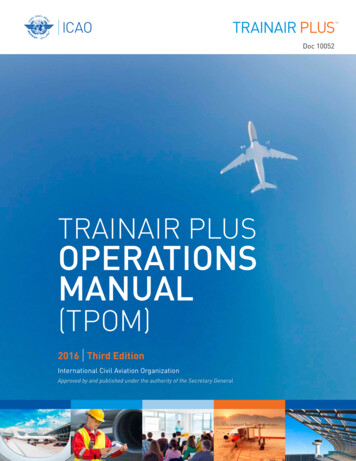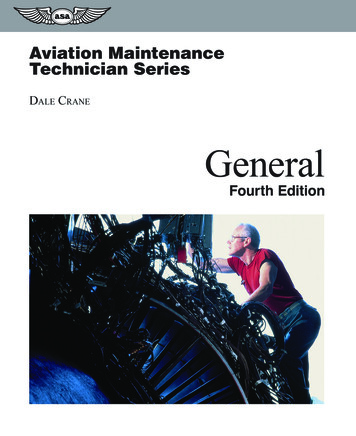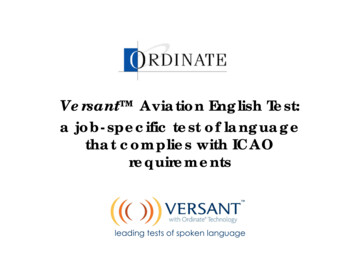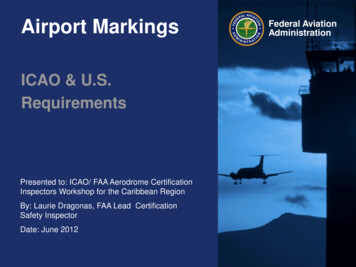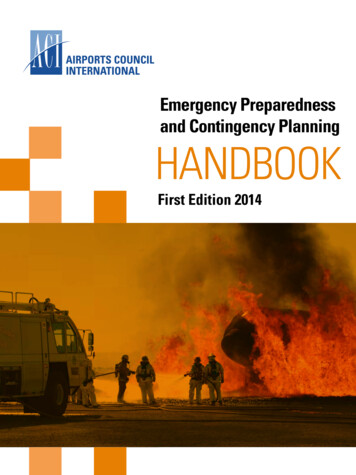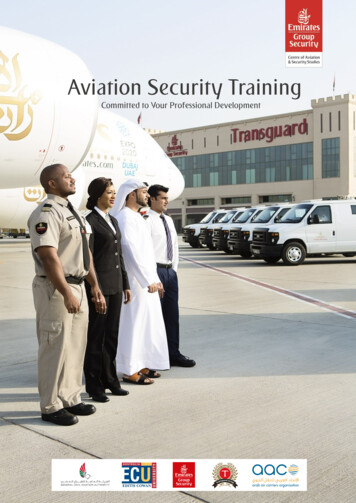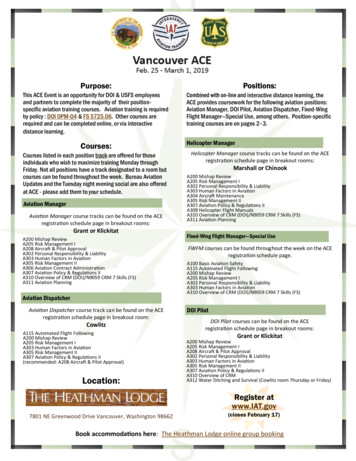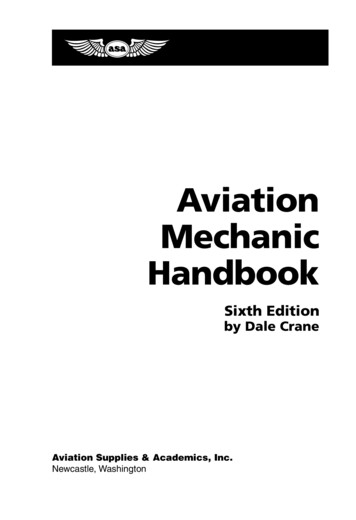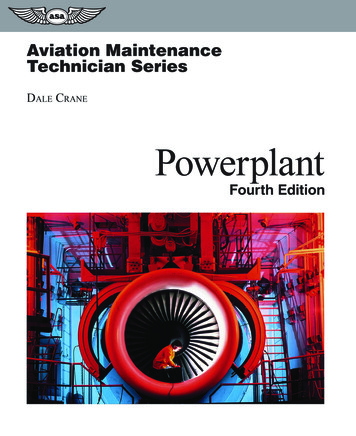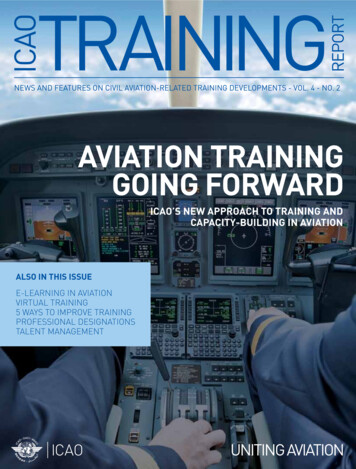
Transcription
REPORTICAOTRAININGNEWS AND FEATURES ON CIVIL AVIATION-RELATED TRAINING DEVELOPMENTS - VOL. 4 - NO. 2AVIATION TRAININGGOING FORWARDICAO’S NEW APPROACH TO TRAINING ANDCAPACITY-BUILDING IN AVIATIONALSO IN THIS ISSUEE-LEARNING IN AVIATIONVIRTUAL TRAINING5 WAYS TO IMPROVE TRAININGPROFESSIONAL DESIGNATIONSTALENT MANAGEMENTUNITING AVIATION
ContentsICAO TRAINING ReportVolume 4, Number 2, 2014EditorialGlobal Aviation Training OfficeEditor-in-Chief: Hervé TouronTel: 1 (514) 954-8219 ext. 6314E-mail: htouron@icao.intContent DevelopmentSenior Editor: Laurie SelineTel: 1 (514) 954-8219 ext. 5818E-mail: lseline@icao.intProduction and DesignBang MarketingStéphanie KennanTel: 1 (514) 849-2264E-mail: info@bang-marketing.comWeb Site: www.bang-marketing.comAdvertisingFCM Communications Inc.Yves AllardTel: 1 (450) 677-3535Fax: 1 (450) 677-4445E-mail: info@fcmcommunications.caSubmissionsThe ICAO Training Report encourages submissions frominterested individuals, organizations and States wishingto share updates, perspectives or analysis related toglobal civil aviation. For further information on submissiondeadlines and planned issue topics for future editionsof the ICAO Training Report, please contact Hervé Touron,Editor-in-Chief at: htouron@icao.intOpinions expressed in signed articles or in advertisementsappearing in the ICAO Training Report represent the author’s or advertiser’s opinion and do not necessarily reflectthe views of ICAO. The mention of specific companies orproducts in articles or advertisements does not imply thatthey are endorsed or recommended by ICAO in preferenceto others of a similar nature which are not mentionedor advertised.The publishers extend their thanks to the companies,organizations and photographers who graciously suppliedphotographs for this issue.Published byInternational Civil Aviation Organization (ICAO)999 University StreetMontréal, QuébecCanada H3C 5H7Copyright 2014International Civil Aviation OrganizationPrinted by ICAO2Message from Mr. Raymond Benjamin, Secretary General, ICAO:ICAO’s New Approach to Training and Capacity-building in Aviation4Five Ways to Improve TrainingTraining expert, Anders Halskov-Jensen of Sweden’s Entry Point North offershis perspective on how to improve aviation training.8The B787 Dreamliner InductionCapt. Amitabh Singh, Project Manager - B787 chronicles the training challengesfaced by Air India as it entered the B787 Dreamliner into service.12The Changing Aviation Environment Meets Virtual Training:a Moving TargetMichael Kalbow, Head of Training, Airbus Maintenance Training looks at futuretraining to accommodate Generation Y and beyond.16The Use of E-Learning in the Aviation SectorTahsin Uğurlu and Kemal Yüksek of the Turkish Aviation Academy share theirexpertise and best practices in applying e-learning to aviation training.ICAO Partner Briefs2022Airports Council International (ACI):Talent Management for Airport ProfessionalsIn Part 2 of his Human Resources Focus, Kevin Caron, Head, Global Trainingand Human Resources for ACI shows how investing in current and futureairport professionals makes good business sense.International Air Transport Association (IATA):Professional Designations in AviationIATA’s Victor de Barrena-Sarobe highlights the need for professionaldesignations in the aviation industry.28Establishing a New Aviation Training Centre in the United Arab EmiratesKaj Kjoeller Christensen describes the process of setting up the GAL ANSTraining Centre, located in Al Ain, United Arab Emirates.32Sir Seewoosagur Ramgoolam International Airport’s Journey to ExcellenceSerge Petit, CEO of Airports of Mauritius Co. Ltd. describes the Journey toExcellence in Passenger Service initiated by the island nation in early 2011.36Are Pilots the New Threat to Aviation Safety?Gregory Darrow, Vice President, Pan Am International Flight Academyaddresses the need for pilot training to deal with the loss of flying skillsthat may result from automation in the cockpit.
MESSAGE FROM THE SECRETARY GENERALRaymond Benjamin, ICAO Secretary GeneralICAO’s New Approachto Training andCapacity-buildingin Aviation2ICAO training report – number 2 2014
MESSAGE FROM THE SECRETARY GENERALAll of us in the international air transport communityrecognize that the benefits of our global network relystrongly on the availability of qualified and competent personnel.ICAO conducted a 2013 assessment to determine how itcould better assist States with their skilled personnel needs.The 38 th Session of the ICAO Assembly adopted AssemblyResolution A38-12, Appendix D, which encouraged greater ICAOinvolvement in human resources development strategies forthe aviation sector and, together, these factors led to thedevelopment of a new ICAO Civil Aviation Training Policy andthe establishment of a Global Aviation Training (GAT) Office.This office is now responsible for the planning, management andcoordination of all training and human resources activities at ICAO.The establishment of the GAT Office in 2014 is enabling ICAOto better respond to the needs of Member States in a moreconsistent and comprehensive manner. Through it we are nowenhancing the standardization of ICAO training activities andthe quality and provision of services to our Member States andthe aviation community.ICAO Training Policy: The Four PillarsThe implementation of the new ICAO Aviation Training Policy,through the GAT Office, is based on four main pillars. These are:the ICAO TRAINAIR PLUS Programme; ICAO recognition ofbeneficial training offerings and best practices by other aviationstakeholders; the development of specific training packages byICAO to meet aviation priorities; and greater cooperation withMember States, United Nations organizations, international andregional organizations, and educational institutions.GAT is using TRAINAIR PLUS as a driving force for trainingstandardization, capacity-building, course development andinstructional staff training. Through TRAINAIR PLUS, GATleverages a comprehensive network of leading and reliabletraining institutions to support the development and deliveryof training and to provide truly global access to affordable andcompetency-based training packages. The network has alsoThe establishment of the GATOffice in 2014 is enablingICAO to better respond tothe needs of Member Statesin a more consistent andcomprehensive manner.welcomed industry players who may join as Corporate Membersin order to enhance the exchange of best practices.RTCE NetworkEarlier this year, ICAO launched the exclusive ICAO RegionalTraining Centres of Excellence (RTCEs) network, comprised ofleading TRAINAIR PLUS Full Members in each ICAO region. TheseRTCEs are selected by the GAT Office based on specific criteriaand will be responsible for the development and delivery of ICAOtraining courses in authorized subject areas, such as aerodromes,air navigation services, air transport, environment, flight safetyand safety management, and security and facilitation.All courses developed by the RTCEs will be ICAO courses andbased around ICAO Standards and Recommended Practices(SARPs) and guidance material. This will enhance the qualityof aviation training delivered to States and ensure ICAO thatprovisions are well understood.As of December 2014, six RTCES have been selected in threedifferent regions: École Nationale de l’Aviation Civile (France) Incheon Airport Aviation Academy (Korea) GMR Aviation Academy (India) Gulf Centre for Aviation Studies (United Arab Emirates) Joint Aviation Authorities Training Organization(The Netherlands) Singapore Aviation Academy (Singapore)Several other important deliverables have been realized byICAO since the inception of the GAT Office including: Development of a competency framework andimplementation of procedures for the selection, evaluation,and training of ICAO-qualified instructors; Establishment of online tools supporting the developmentand delivery of training courses and assessment of trainingorganizations to ensure their compliance with ICAO guidelines; Creation of a GAT webpage (http://www.icao.int/Training)on the ICAO public website; Establishment of a Training Scholarship Programme forleast-developed countries.ICAO is also organizing, with the assistance of its MemberStates and international organizations, global and regionalaviation training events to promote greater capacity-buildingand training in aviation. The next global event is scheduledto be held in Dublin, Ireland, from 24–27 March 2015. I wouldencourage all States, training organizations and professionalsin the aviation industry to attend these important gatherings.This new approach to training by ICAO is marking a shift in theway we deal with human resources development strategies.I am confident that it will help contribute to the more effectiveand harmonized implementation of SARPs and that it will senda strong signal to our sector that ICAO has made global aviationtraining one of its most important priorities.ICAO training report – number 2 20143
TRAINING INNOVATIONFive Ways toImprove Training“That’s how we’ve always done it”. This sentence more or less sums up one of thebarriers for improvement in aviation training today. The reluctance to change wasthe main topic for my presentations at various ICAO events last year, under theheadline Changes in the Aviation Environment and the Impact on Training.ABOUT AndersHalskov-JensenWith a background as an airtraffic controller in Denmark andOman, Anders Halskov-Jensenhas spent 26 years in the aviationindustry, in training, systemdesign and test, simulationin addition to a great deal ofinternational work. Followingfour years as a training expertat Entry Point North, Anders hasnow assumed the position ofClient Manager for internationalcustomers.4ICAO training report – number 2 2014I have a background as an air traffic controller and I’ve had the privilege of workingwith and meeting fellow controllers from all over the world. I have always admiredthe people in my profession for their ability to adapt to all kinds of changes; bethey new regulations, technology or procedures. But I have also been puzzled withmy colleagues’ (and my own) reluctance to embrace or accept changes, until therealization sets in that there is no way around them. Controllers like the currentsituation, almost regardless of the suggested future.The same reluctance is often visible in operational aviation organizations andtraining departments where focus normally is on running operations and less onnecessary training. For this reason, training may go unchanged for years simplybecause the outcome is acceptable and the necessary resources to review thetraining might never be allocated.I have spent the last seven years of my career at a training academy, Entry Point North inSweden. Being in an organization whose sole purpose is to provide training gives one adifferent perspective on education. During the lifespan of our academy, we’ve made manychanges in order to constantly improve what we do. As a company that exists on marketterms, we have to be on our toes so that our customers are satisfied with our services.
TRAINING INNOVATION training may gounchanged for yearssimply because theoutcome is acceptableand the necessaryresources to reviewthe training mightnever be allocated.So, let’s take a look at how training can be improved byimplementing the right kinds of changes.#1. Change something anything.In your organization, you might be content with the outcome ofyour training. Students will receive the same education you hadmany years ago, and the way you do things in your organizationhas been proven effective over years with a stable success rateof 52%. That’s great. But what if it could be increased to 60%,70% or higher? Solid training results are not the same as idealor maximum training results. If nobody remembers the reasonsfor “having always done it this way”, perhaps it’s about time tochange something.#2. Review your training.Training should be reviewed regularly, ideally after eachcourse. Feedback from students, instructors and teachersshould be gathered, analysed and discussed before decidingon which changes (read “improvements”) should beimplemented. In a busy organization, this step is easilyneglected, especially if everybody is happy with the outcome.However, the aftermath of a training session is the best timeto reflect on how things were done and how they might beimproved. In a training organization like Entry Point North,where all we do is training, it’s easier to establish regularreviews. But even we have to remind ourselves every nowand then. I would guess that you do too. Correct?#3. Review instructors and teachers.Even if this might seem slightly controversial, it’s importantto look at the staff you have for training. You can select thebest pilot, air traffic controller or engineer in the world, andhe might be the worst teacher or instructor ever. Teaching andinstructing is also a professional skill. In our industry, there isa tendency to merely select somebody for training dutieswithout considering their motivation or teaching skills. Buthey, that’s how we’ve always done it, right? And this leads medirectly to the fact that #4. Teaching is also a profession.It takes years to become a teacher. It is a profession. You needto study. And yet, in many professions, including aviation, it’sICAO training report – number 2 20145
TRAINING INNOVATIONcommon to take anybody with the competencies of the tradeand put them in a classroom to teach everybody else. It mightnot be the optimum way of doing things. You cannot put ateacher behind a radar screen or the controls of an aircraftand expect him or her to separate traffic or fly an aircraft.And yet we put controllers and pilots in classrooms and expectthem to teach. Why? You must provide your training staff withprofessional training education. It will significantly improvethe outcome of training.#5 Change your view of the students.When I trained to become a controller some 30 years ago,the view of students was simple. If you made it through thetraining, that’s fine. You had what it took. If not, too bad.We’ll find somebody else. A low success rate was generallyaccepted, as well as the assumption that it was difficult, ifnot impossible, to screen properly for the right skills for thetrade. And no attention was paid to the individual student.Today, recruitment and selection processes have improvedsignificantly. But on top of that, it’s also important to recognizestudents as future colleagues and as individuals who mightneed to be treated differently through difficult training. Ofcourse, what one can do may be limited by financial or timeconstraints. However, aviation training is expensive andproviding students with individualized attention may wellbe worth the effort.At Entry Point North, we try to make students aware of theirindividual learning style and whenever a student encountersproblems, we create individual action plans together with thestudent and the relevant instructors. The responsibility forcompleting the training does not rest with the student alone.It is shared with teachers, instructors and the academy itself.This approach has increased our success rate over the years.If nobody remembersthe reasons for “havingalways done it thisway”, perhaps it’sabout time to changesomething.6ICAO training report – number 2 2014Be also aware that generations differ. The current Generation Yis very different from my Generation X. They have other needsand expectations. They behave differently. The training that youprovide should take this into consideration.In general, changes should be welcomed and embraced. Withinaviation, many changes are forced upon us by new legislation ortechnology. Consequently, we change operations and trainingto adapt. But we can also implement changes as the result of adesire to improve things - to make things better. By regularlyreviewing how we train and the outcomes we achieve, we canimplement the necessary changes and training can continuouslycontribute to a better and safer aviation industry.Aviation has always been a very dynamic environment. This isthe one characteristic that will never change.
AIRCRAFT INDUCTIONThe B787DreamlinerInduction: Facingthe Challenges ofTraining for a NewAircraft TypeAir India was among the first customers to embrace the cutting edge technologyof the Boeing B787 Dreamliner. On 30 December 2005, Air India Ltd. signedpurchase agreements with Boeing and General Electric for 50 Boeing aircraft(with GE engines), which included 27 B787-8 medium capacity long range aircraftwith a seating capacity of 258, at an estimated project cost of Rs. 33,197 crore(USD 7.377 billion).Following years of delay, the aircraft was finally ready for entry into service bylate 2011.About Capt. Amitabh SinghHe has a rich career in aviation,spanning over 28 years. He hasworked in various capacitiesas a pilot and an executive,with Ms. Vayudoot and AirIndia Ltd. He has successfullyhandled the responsibility ofProject Manager - B787 AircraftInduction Programme, while alsoheading the Training Division asChief of Training (Boeing -WideBody Fleet). He led the team ofsenior experienced pilots fromAir India for B787 Flight Crewcourse evaluation, along withthe DGCA. He was also a partof the team that flew the firstB787 from Charleston (USA) toIndia. Presently, he is handlingFlight Operations as GeneralManager-Ops., at the companyheadquarters located atNew Delhi.8ICAO training report – number 2 2014While Air India has excellent manpower resources and unparalleled experiencein all fields of aviation including Flight Operations, Operations Engineering andMaintenance and Ground Handling, induction of B787-8 posed some unique andunprecedented challenges:A composite aircraftAir India’s one-of-a-kind maintenance facility in Mumbai, was equipped to performmajor checks and maintenance for both Airbus and Boeing conventional metalbody aircraft. However, the composite construction of the B787 aircraftdemanded the creation of a composite repair facility. This was relatively easyto accomplish. The existing manufacturing facility was reconfigured throughexpansion and modernization to meet the new and enhanced infrastructuralrequirements recommended by Boeing.However, orientation and training of technical personnel in this new technologyproved to be a far more arduous task. In order to ensure minimum ground timefor aircraft maintenance, the technical personnel were provided with thoroughin-house training prior to regulatory training at the manufacturer’s facility. Thisnot only enhanced familiarization for personnel, but also increased the rate ofturnout of trained manpower.
Regulatory stipulationsSince the B787 was a new type of aircraft being introducedglobally and Air India was one of the launch customers, India’snational regulatory authority, The Directorate General of CivilAviation, was required to be thoroughly familiar with the uniquefeatures of the aircraft, the type certification process to befollowed and the limitations of the aircraft. Further, thetraining requirements recommended by the manufacturerneeded to be vetted and approved, to enable formulation ofa robust training plan.Delays in aircraft deliveryThe uncertainty of the aircraft delivery date posed someunique challenges. The Regulatory Authority required theaircraft to be type certified in order to grant approval forthe aircraft type-specific courses to be conducted for theflight crew, cabin crew, engineers etc., while, at the same time,commercial business interests expected the new product,with its advanced features, to be put into service as quicklyas possible upon delivery of the first aircraft.Meeting the challengesThe most immediate task at hand was training and qualificationof personnel beginning with the maintenance engineers. Thefirst batch of training for Licensed Aircraft MaintenanceEngineers began as early as August 2010 at the manufacturer’straining facility.Next, Air India, in coordination with the DGCA, India, initiatedthe evaluation of the FAA approved Flight Crew TrainingProgramme from December 2010 through February 2011.During this period, a team of experienced senior pilots fromthe B777 and A320 fleet and designated Flight StandardsWhen the aircraft deliveryfinally firmed up in the lastweek of August 2012, therequalification of pilots wasrestarted on a war footing.ICAO training report – number 2 20149
XXXAIRCRAFT INDUCTIONDirectorate Inspectors underwent the various coursesoffered in order to evaluate the adequacy and relevance ofthe course contents and recommend additional training toensure safe operations.Subsequent to the evaluation of the FAA approved courses andconsidering the inherent training and systemic requirements,the course footprints were enhanced by approximately 9.5%for Full Transition, 21% for Shortened Transition and 83%Differences Training. Special emphasis portions wereincorporated to cater to the introduction of Heads Up Display,Electronic Flight Bag, Onboard Performance Tool, etc.Capt. Amitabh Singh, Project Manager-B787 with the Boeing officials atthe South Carolina based aircraft manufacturing facility.Although the training syllabus and facility were accorded DGCAapproval in March 2012, the flight crew training could not beginimmediately as the aircraft delivery date continued to bepostponed. The decision on commencement of training had tobe taken in consideration of the fact that Flight Crew Recencyrequirements stipulated that the training be completed within90 days of entry into revenue services. Scheduling the trainingearlier, would entail additional training costs in order to meetthe Recency requirements. On the other hand, delaying trainingwould result in the non-availability of crew for flight operationswhen the revenue flights commenced.In anticipation of the first aircraft delivery, expected aroundmid-June 2012, the flight crew training was finally started inmid-April 2012. However, we had to pause the training midwayin July 2012 as the aircraft delivery was further delayed. As aninterim measure, management reassigned the pilots back tofeeder fleets to ensure adequate crew utilization.When the aircraft delivery finally firmed up in the last week ofAugust 2012, the requalification of pilots was restarted on awar footing. This requalification was carried out on a trainingfootprint which ensured that the pilots were sufficientlycompetent to fly the B787. Taking into account the fact thatthey had to undergo reconversion and operate their previousfleet during the interim period, this exercise was conducted toenable effective risk mitigation.More surprisesMajor operational safety issues kept cropping up: battery fires,ice crystal icing, etc. These resulted in the FAA and the DGCAissuing directives to ground the newly inducted fleet. This putan unprecedented strain on the training resources, as it not onlyresulted in pilot recency issues, but also the ongoing conversiontraining, which had to be abruptly halted.B787 Induction Team.10ICAO training report – number 2 2014The final challenge came in the form of qualifying companypilots to enable ferrying the first delivery flight into thecountry. Assisted by the Master Differences Requirementtables published in the B787 Flight Standardization BoardReport issued by the FAA and the Operational Evaluation Board
AIRCRAFT INDUCTIONOn 10 July 2013, AirIndia achieved the uniquedistinction of beingapproved as the secondType Rating TrainingOrganization (TRTO) inthe world to offer B787Type Rating training,the first being themanufacturer itself.Report issued by the EASA, an enhanced training module wasdesigned, which, after a thorough scrutiny by the regulatoryagency and the Ministry of Civil Aviation, Government of India,authorized designated senior experienced pilots to ferry thefirst delivery flight into the country, after undergoing theadditional simulator training, which was conducted in-house atour Mumbai training facility.The Boeing fleet training facility of the company located inMumbai was designated as the site for installation of the B787Full Flight Simulator (FFS). The FFS manufactured by M/sThales, conforms to “Interim Level-C”. This simulator wasapproved by the DGCA in May 2012, and put into service withimmediate effect.The final outcomeBy the time the first aircraft landed in the country, we hadimparted training to 65 pilots; 238 technical personnelincluding aircraft engineers, technicians, and groundinstructors; 187 cabin crew; and 58 flight dispatchers.On 10 July 2013, Air India achieved the unique distinction ofbeing approved as the second Type Rating Training Organization(TRTO) in the world to offer B787 Type Rating training, the firstbeing the manufacturer itself.ICAO training report – number 2 201411
XXXFUTURE TRAININGThe Changing AviationEnvironment MeetsVirtual Training:a Moving TargetCredit: e*m company / P. MASCLETMany organizations in the aviation training industry are trying to adapt rapidly tothe challenges of responding to the increasing demands of training new entrantsto commercial aviation. The apparently unending growth in demand means that,as the numbers ramp up, development of innovative, effective and efficient waysof training in all aviation disciplines is critical.About Michael KalbowIn his role as Head of Training,Airbus Maintenance Training,Michael is responsible for thedevelopment and implementationof the Airbus maintenancetraining strategy. This includesstandardization of pedagogy,training technology andairworthiness requirementsapplicable for all Airbusmaintenance training centresworldwide. His experience includesdelivery of training courses asinstructor and the developmentof training systems covering allaspects of training from classicalapproaches to blended learningincluding e-learning, simulationand virtual reality.One approach to this is an evolutionary path over a period of the next five to tenyears. The crux of this approach was articulated in an article developed withChris Long, Editor for European Affairs, CAT Magazine, Halldale Media, in the2-2013 Issue entitled: Training – a Philosophy for the Future.Because I represent a leading aircraft OEM, I obviously have a focused interest inmaintenance training and, in particular, Type Qualification for the Airbus. However,many of the ideas expressed here apply to future training across the board.A virtual worldTo briefly describe the evolution of this type of training, it has moved from classicclassroom theory/workshop practice (See Figure 1 “Chalk and Talk” and Figure 2“Practical”) and supervised work on aircraft to technological improvements suchas CAT (Computer Aided Training, Video Assisted and Computer BasedI wish to open a discussion on the philosophy which will mould future training.There is certainly a fluidity to the way this training will develop.However, it is not simply the application of emerging technology or newmethodology, but, perhaps more critically, the evolution in the talentsand mindsets of those who will drive the industry in the future. Not onlyis this requirement self-evident, but it reflects the bigger picture incommercial operations.With great pleasure, I follow EASA’s recent initiative to orientate relevanttraining rules towards this new reality by launching the NPA2014-22 forcomments. Recent technical glitches aside, the focus of interest is movingaway from “mere” technology to look very closely at the integrationof people and the way they interact with the technology.A new way of thinking will be necessary across all training disciplines and skills,and the shape of that thinking is still under development.12ICAO training report – number 2 2014
FUTURE TRAINING any changes tomaintenance trainingmust respect the need forcost-efficient deployment –either close to the customeror in a virtual, immersiveworld that is accessibleanywhere and, ideally,anytime.Instruction (VACBI ) and Computer Based Training (CBT), andto a newer world of Virtual Aircraft based on simulation andimmersive technologies.While I make the distinction between the varying levels ofimmersion in this virtual world, there is little doubt that it will,not only complement what is presently being delivered, butexpand and improve the training environment.Catering to a new generation of traineesAlongside these changes in technology has been the emergenceof Generation Y, who exhibit a radically different mindset fromtheir predecessors. Among the strengths shown by this group istheir ability to study and work in complex situations – absorbingand moving easily in a world where there are multiple andinstantaneous inputs. This fits naturally in an aeronauticalworld where the intrinsic interdependence of aircraft systemsrequires an immediate understanding of the effect of an actionin one part of the system on all the other systems.The classic subdivision of independent systems (e.g. hydraulicsor electrical systems) is no longer relevant; nor is the study ofthese systems as separate entities appropriate. We, as an OEM,receive more and more feedback from airlines and MROs thattheir young, latest generation entrants to the industry are nolonger interested in classic classroom training, but feel betteradapted to competence and scenario-based training systems.The Training by Airbus ACT concept (Airbus CompetenceTraining available for all Airbus families; A320, A330, A380 andA350) is one appropriate answer to their needs.How much does it cost?While Part 147 approved training organizations do their utmostto comply with its associated rules, one key driver for strategicICAO training report – number 2 201413
FUTURE TRAININGFigure 1: Chalk and TalkWe, as an OEM, receive moreand more feedback fromairlines and MROs that theiryoung, latest generationentrants to the industryare no longer interested inclassic classroom training,but feel better adapted tocompetence and scenariobased training
addresses the need for pilot training to deal with the loss of flying skills that may result from automation in the cockpit. 20 28 32 36 ICAO TRAINING Rep ORT VOlume 4, Numbe R 2, 2014 editorial Global Aviation Training
